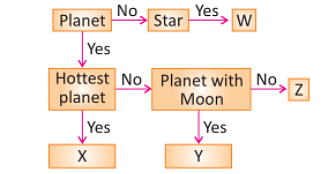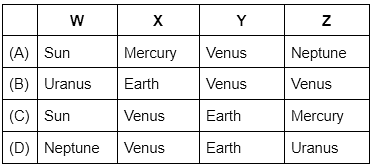Olympiad Test Level 2: Earth and Universe - Class 3 MCQ
10 Questions MCQ Test Science Olympiad for Class 3 - Olympiad Test Level 2: Earth and Universe
Even though Sun casts its hot rays on earth, we do not feel very hot because–
Read the two statements carefully
STATEMENT A: The sun is the largest object of the solar system.
STATEMENT B: There is an atmosphere on the moon, so life can exist on it.
Choose the correct option
| 1 Crore+ students have signed up on EduRev. Have you? Download the App |
Fill in the blanks in the given paragraph with words given in the Box and select the correct option–

Earth orbits the ______ once in about 365 days. This is also called _______ Due to this, we experience different _______

Refer to the given diagram of a part of the solar system. Identify the natural satellite in it–

When the Moon is completely hidden by the shadow of the Earth, the Eclipse formed is
Which of the given planets takes the longest time to rotate once?
Read the following statements:
(1) The Earth is about a million km away from the sun._______
(2) The Earth completes one rotation on its axis in about hours._______
(3) The Moon completes one rotation on its axis in about days._______
(4) After the new Moon, the Moon is the next phase of the Moon._______
Select the option that correctly fills the blanks in the above statements.
Select the figure that shows the correct position of Earth (E), Moon (M) and Sun (S) during a solar eclipse.
Study the given flow chart and identify W, X, Y and Z.


|
36 videos|39 docs|58 tests
|
|
36 videos|39 docs|58 tests
|

















